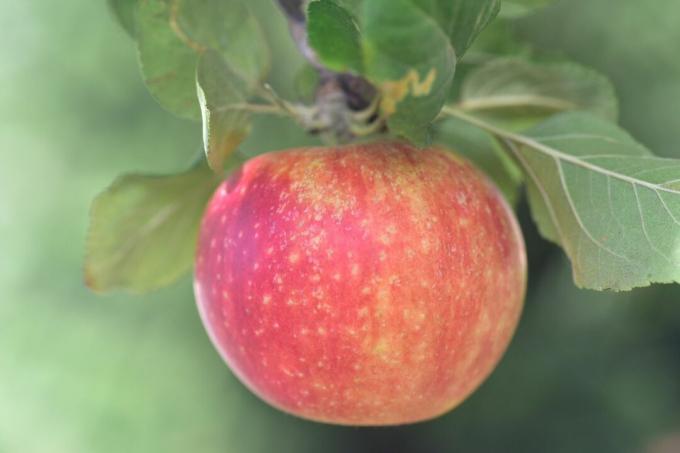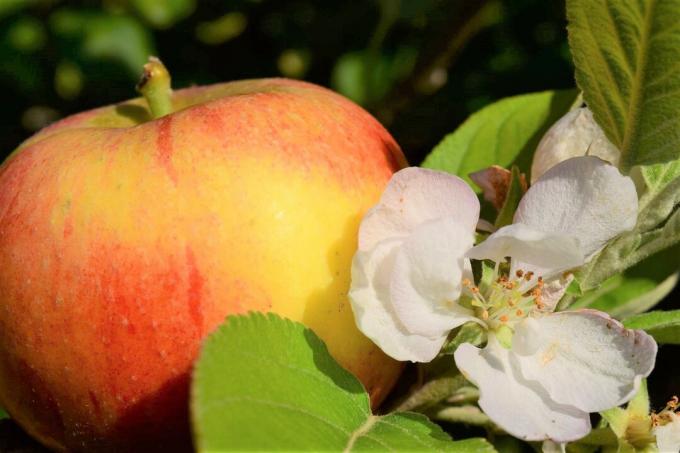Because of its excellent taste, the 'Alkmene' apple variety is still extremely popular, even if it is not one of the most productive apple varieties. We show how the 'Alkmene' apple variety came about, how it tastes and how it can be successfully cultivated.

The 'Alkmene' apple is one of the traditional types of table fruit and is still highly valued by many today because of its exquisite taste. Unfortunately, however, it hardly gets any attention in large-scale apple production, so that it is rarely found on supermarket shelves. However, if you don't want to do without the delicious apple variety, you can grow the hardy 'Alkmene' in your own garden. You can find out what you need to consider in this article in this article.
contents
- ‘Alkmene’: profile
- Origin and history of the apple variety 'Alkmene'
- Properties and taste of ‘Alkmene’
- Peculiarities when cultivating the Alkmene apple tree
- Alcmene: Harvest time and use of the variety
‘Alkmene’: profile
| fruit | small to medium sized; golden yellow, orange-red on the sunny side |
| the taste | aromatic, slightly acidic |
| yield | high and regular |
| harvest time | from September |
| maturity | mid-September to late October |
| shelf life | medium; can be stored until the end of November |
| growth | medium to strong |
| climate | mild; tolerates windy conditions |
| diseases and pests | very susceptible to fire blight, fruit tree canker, sunburn, spider mites |
Origin and history of the apple variety 'Alkmene'
The apple variety 'Alkmene' has its origins in Müncheberg, Germany, where it was planted in 1930 Kaiser Wilhelm Institute for Breeding Research specifically for successful cultivation in drier areas was bred. This was achieved by crossing the demanding English variety 'Cox Orange', the characteristics of which should largely be found in the 'Alcmene' and the 19th century. Century table apple ‘Privy Councilor Dr. Oldenburg'.
Properties and taste of ‘Alkmene’
The small to medium-sized, round-shaped fruits of the 'Alkmene' can hardly be distinguished from their father variety 'Cox Orange', because both are characterized by their golden yellow and orange-red color on the sunny side, the thin and smooth skin and their green-yellow, crunchy flesh the end. The particularly aromatic, slightly sour taste is also reminiscent of the famous English table apple. Although their yield is regular and high, it cannot compete with the yield of typical cultivated apple varieties such as 'Golden Delicious' keep up, so that the 'Alkmene' is rarely cultivated conventionally. The early autumn variety is ready for picking at the beginning of September and is ready for consumption from mid-September to the end of October. The 'Alkmene' shows no fruit drop.

From the end of April to mid-May, the 'Alkmene' shows a rich bloom on its tree: the white-pink colored flowers are not only pretty, but also have a particularly long flowering period. For this reason, the 'Alkmene' is also very popular with bees and bumblebees, so that it can make a valuable contribution to nature conservation. In contrast to the 'Cox Orange', it is significantly more resistant to powdery mildew and scab, two of the most common diseases in apple production. However, it is very susceptible to fire blight and fruit tree cancer, but also for sunburn and the infestation of spider mites.
Peculiarities when cultivating the Alkmene apple tree
Apple trees of the 'Alkmene' variety feel particularly comfortable in mild regions. The ideal location for the robust apple is a semi-shady place, as otherwise it tends to sunburn easily, which can reduce yields. Unlike its father variety 'Cox Orange', 'Alkmene' can also cope with dry to moderately fresh soils. In order for the apple variety to develop well, however, it is also important to ensure that the soil is drained and rich in nutrients. The 'Alkmene' can also usually tolerate windy locations well.
Depending on the location and care, the Alkmene apple tree shows medium to strong, upright growth. However, restrained pruning and careful fertilization can limit the growth of the 'Alkmene', so that the tree can also be integrated into smaller gardens. As with other apple varieties, regular pruning is essential for long-term fruit development. You can find out how to achieve a good balance between the formation of new shoots and the yield with the right pruning in our special article "Pruning an apple tree: expert guidance“.

Like all apple trees, the 'Alkmene' is a cordial root, so it is actually optimally equipped to with the required nutrients from the deep and more near-surface soil layers supply. Nevertheless, in addition to pruning, fertilizing can also be a useful support for the growth of your apple tree. But be careful: Too much fertilizer can also cause immense damage to your tree. You can find out how best to proceed when fertilizing an apple tree in our article "Fertilize apple trees: You should follow these tips“.
Alcmene: Harvest time and use of the variety
The early autumn variety is ready for picking at the beginning of September and is then ready for consumption from mid-September to the end of October. Unfortunately, the 'Alkmene' is only suitable as a storage apple to a limited extent, as it is very susceptible to rot and tends to tan quickly. If stored in a cool place at around 2 °C, the 'Alkmene' can usually be stored until the end of November.
Thanks to its fine taste, 'Alkmene' is an excellent dessert fruit. Their tasty, sour aroma also gives baked goods such as apple pie or apple strudel a special touch. However, if you want to enjoy your apples a little longer, we recommend that you squeeze a delicious juice from the apples or boil them down with a little sugar to make applesauce.
If you are looking for an apple with a better shelf life then this is it 'Ontario' definitely something for you - the table apple can be stored until May.



